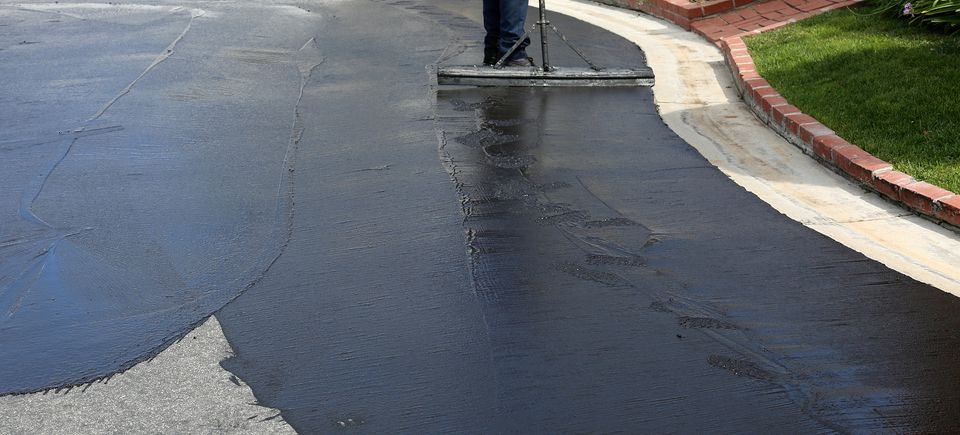Understanding Tilted Parking: How Asphalt Sealing Boosts Business Whole Lots
Understanding Tilted Parking: How Asphalt Sealing Boosts Business Whole Lots
Blog Article
Hot Mix Asphalt: A Sustainable Remedy for Sidewalk
Hot Mix Asphalt (HMA) has arised as a leading sustainable selection for sidewalk solutions, supplying a myriad of environmental advantages and innovative modern technologies. As the demand for environmentally friendly construction techniques expands, checking out the subtleties of HMA's sustainability can give useful insights right into the future of pavement remedies.
Environmental Advantages of Hot Mix Asphalt
.png)
Moreover, Hot Mix Asphalt assists to alleviate metropolitan heat island results. Its dark color takes in sunshine, minimizing the quantity of warm mirrored back into the environment compared to lighter-colored pavements. This can decrease ambient temperatures in metropolitan areas, lowering the demand for a/c and ultimately minimizing power consumption.
Additionally, Hot Mix Asphalt adds to boosted stormwater administration. Its permeable nature permits water to charge and infiltrate the pavement groundwater materials, lowering drainage and the threat of flooding. These ecological benefits make Hot Mix Asphalt a sustainable selection for leading highways and roads.
Power Effectiveness in HMA Production
Is power performance an essential variable in the manufacturing of Hot Mix Asphalt (HMA)? Power plays a significant function in the manufacturing of HMA, influencing both expense and environmental sustainability. One vital element of energy performance in HMA manufacturing is the use of cozy mix asphalt (WMA) technologies.
Furthermore, innovations in plant technologies have brought about even more energy-efficient HMA production processes. Modern plants are made with functions like recycled asphalt pavement (RAP) processing capabilities, effective heater systems, and boosted insulation, all adding to power cost savings. By optimizing energy use in HMA production, the industry can minimize its carbon impact while preserving high-quality sidewalk materials. Energy performance is, as a result, a critical factor to consider in guaranteeing the sustainability of Warm Mix Asphalt manufacturing.
Recyclability of Warm Mix Asphalt
The recyclability of Warm Mix Asphalt (HMA) is an essential aspect of its sustainability and lasting environmental impact. HMA is among one of the most recycled products in the United States, with over 100 million lots of reclaimed asphalt pavement (RAP) being reused each year in brand-new sidewalk building. Reusing HMA supplies several environmental benefits, such as minimizing the need for virgin materials, lowering energy usage during manufacturing, and reducing the amount of waste sent to landfills.
The process of reusing HMA entails milling the existing pavement, squashing it right into smaller sized items, and blending it with brand-new accumulation and asphalt binder to develop a recycled mix. This recycled mix can often carry out along with and even much better than traditional HMA, while needing fewer basic materials and producing lower greenhouse gas discharges. By incorporating RAP into brand-new pavement projects, roadway firms can preserve all-natural resources, minimize costs, and lessen the environmental footprint of road construction and maintenance activities. On the whole, the recyclability of HMA plays a substantial duty in advertising lasting techniques within the sidewalk industry.

Long-Term Efficiency of HMA
Asphalt sidewalks show sturdiness and durability over a prolonged duration, mirroring the long-lasting performance of Hot Mix Asphalt (HMA) The longevity of HMA go to my site can be associated to its capacity to endure rush hour loads, harsh climate condition, and the effects of aging. Studies have revealed that well-designed and correctly constructed HMA pavements can last for 20 years or even more with normal maintenance. The key to optimizing the lasting performance of HMA hinges on using high-quality products, adhering to finest methods in construction, and implementing reliable upkeep techniques. Correct drain, routine inspections, and prompt repair services are essential for maintaining the architectural integrity of HMA sidewalks gradually. Furthermore, improvements in HMA technology, such as using polymer-modified binders and warm mix asphalt, have actually even more enhanced the resilience and durability of HMA sidewalks. By focusing on high quality construction and upkeep methods, HMA continues to verify itself as a sustainable and cost-efficient solution for durable pavement framework.

HMA: Sturdiness and Sustainability
Demonstrating both longevity and sustainability, Warm Mix Asphalt (HMA) has actually ended up being a cornerstone in the construction of long-lasting sidewalk infrastructures - hot mix asphalt. HMA's sturdiness originates from its ability to endure heavy loads, rough climate condition, and high traffic volumes, making it a trustworthy choice for streets, highways, and airport terminal paths. The make-up of HMA, which generally includes accumulations, binder, and filler, plays an essential function in improving its durability and resistance to tear and use
Furthermore, HMA's sustainability lies in its recyclability and energy-efficient production procedure. The capacity to reuse recovered asphalt sidewalk (RAP) in new HMA combinations minimizes the demand for virgin materials and decreases the environmental influence of pavement check out this site building and construction and upkeep. In addition, the energy performance of creating HMA hinges on its reduced mixing temperatures compared to various other pavement products, resulting in minimized energy usage and greenhouse gas discharges.
Final Thought
In final thought, warm mix asphalt (HMA) supplies a lasting solution for sidewalk with its ecologically pleasant features. HMA's recyclability, power effectiveness in manufacturing, and lasting sturdiness make it an environmentally friendly choice for road building and construction.
HMA is one of the most recycled materials in the United States, with over 100 million bunches of redeemed asphalt pavement (RAP) being recycled annually in new sidewalk building.The process of recycling HMA includes grating the existing pavement, crushing it into smaller sized pieces, and blending it with new aggregate and asphalt binder to develop a recycled mix.Asphalt pavements demonstrate longevity and strength over an extended period, showing the long-term efficiency of Hot Mix Asphalt (HMA) In addition, you could check here improvements in HMA modern technology, such as the usage of polymer-modified binders and warm mix asphalt, have better improved the sturdiness and durability of HMA pavements. The capability to reuse reclaimed asphalt pavement (RAP) in new HMA mixes reduces the need for virgin materials and reduces the ecological influence of sidewalk construction and maintenance.
Report this page